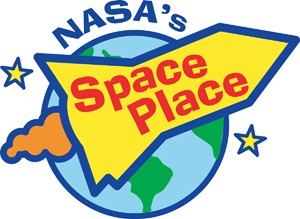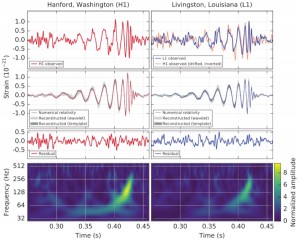Imagine a world very different from our own: permanently shrouded in clouds, where the sky was never seen. Never had anyone see the Sun, the Moon, the stars or planets, until one night, a single bright object shone through. Imagine that you saw not only a bright point of light against a dark backdrop of sky, but that you could see a banded structure, a ringed system around it and perhaps even a bright satellite: a moon. That’s the magnitude of what LIGO (the Laser Interferometer Gravitational-wave Observatory) saw, when it directly detected gravitational waves for the first time.
An unavoidable prediction of Einstein’s General Relativity, gravitational waves emerge whenever a mass gets accelerated. For most systems — like Earth orbiting the Sun — the waves are so weak that it would take many times the age of the Universe to notice. But when very massive objects orbit at very short distances, the orbits decay noticeably and rapidly, producing potentially observable gravitational waves. Systems such as the binary pulsar PSR B1913+16 [the subtlety here is that binary pulsars may contain a single neutron star, so it’s best to be specific], where two neutron stars orbit one another at very short distances, had previously shown this phenomenon of orbital decay, but gravitational waves had never been directly detected until now.
When a gravitational wave passes through an objects, it simultaneously stretches and compresses space along mutually perpendicular directions: first horizontally, then vertically, in an oscillating fashion. The LIGO detectors work by splitting a laser beam into perpendicular “arms,” letting the beams reflect back and forth in each arm hundreds of times (for an effective path lengths of hundreds of km), and then recombining them at a photodetector. The interference pattern seen there will shift, predictably, if gravitational waves pass through and change the effective path lengths of the arms. Over a span of 20 milliseconds on September 14, 2015, both LIGO detectors (in Louisiana and Washington) saw identical stretching-and-compressing patterns. From that tiny amount of data, scientists were able to conclude that two black holes, of 36 and 29 solar masses apiece, merged together, emitting 5% of their total mass into gravitational wave energy, via Einstein’s E = mc2.
During that event, more energy was emitted in gravitational waves than by all the stars in the observable Universe combined. The entire Earth was compressed by less than the width of a proton during this event, yet thanks to LIGO’s incredible precision, we were able to detect it. At least a handful of these events are expected every year. In the future, different observatories, such as NANOGrav (which uses radiotelescopes to the delay caused by gravitational waves on pulsar radiation) and the space mission LISA will detect gravitational waves from supermassive black holes and many other sources. We’ve just seen our first event using a new type of astronomy, and can now test black holes and gravity like never before.
Image credit: Observation of Gravitational Waves from a Binary Black Hole Merger B. P. Abbott et al., (LIGO Scientific Collaboration and Virgo Collaboration), Physical Review Letters 116, 061102 (2016). This figure shows the data (top panels) at the Washington and Louisiana LIGO stations, the predicted signal from Einstein’s theory (middle panels), and the inferred signals (bottom panels). The signals matched perfectly in both detectors.
This article is provided by NASA Space Place.
With articles, activities, crafts, games, and lesson plans, NASA Space Place encourages everyone to get excited about science and technology. Visit spaceplace.nasa.gov to explore space and Earth science!


